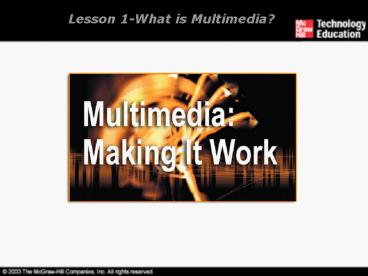Overview - PowerPoint PPT Presentation
1 / 21
Title:
Overview
Description:
Multimedia is a combination of text, art, sound, animation, and video. ... into document with HTML (Hypertext Markup Language) or DHTML (Dynamic HTML) ... – PowerPoint PPT presentation
Number of Views:57
Avg rating:3.0/5.0
Title: Overview
1
Lesson 1-What is Multimedia?
2
Overview
- Introduction to multimedia.
- Applications of multimedia.
- Virtual reality (VR).
3
Introduction to Multimedia
- Multimedia is a combination of text, art, sound,
animation, and video. - It is delivered to the user by electronic or
digitally manipulated means. - A multimedia project development or a web site
requires creative, technical, organizational, and
business skills. - Keys to successful development of a multimedia
project are - Management of digital tools and skillsets,
- Teamwork,
- General project management,
- Documenting and archiving the process,
- Delivering the completed product on time and
within budget.
4
Introduction to Multimedia-Definitions
- Multimedia is woven combination of digital
manipulated text, photographs, graphic art,
sound, animation, and video elements - Multimedia becomes interactive multimedia when a
user is given the option of controlling the
elements. - Interactive multimedia is called hypermedia when
a user is provided a structure of linked elements
for navigation. - Multimedia developers develop multimedia projects.
5
Introduction to Multimedia-Definitions
- The software vehicle, the messages, and the
content together constitute a multimedia project. - A multimedia project shipped to end-users with or
without instructions is called a multimedia
title. - A project can also be launched on the World Wide
Web (WWW) where you can weave the elements of
multimedia into document with HTML (Hypertext
Markup Language) or DHTML (Dynamic HTML).
6
Introduction to Multimedia-Definitions
- Multimedia projects can be linear or nonlinear.
- Projects that are not interactive are called
linear. - Projects where users are given navigational
control are called non-linear and
user-interactive.
7
Introduction to Multimedia-Definitions
- Authoring tools are used to merge multimedia
elements into a project. - Macromedia Director, Authorware, Ulead Media
Studio - These software tools are designed to manage
individual multimedia elements and provide user
interaction. - The sum of what gets played back and how it is
presented to the viewer on a monitor is the
graphic user interface (GUI). - The hardware and software that govern the limits
of what can happen are the multimedia platform or
environment.
8
Introduction to Multimedia -CD-ROM and the
Multimedia Highway
- The primary media for delivering multimedia
projects are - Compact disc read-only (CD-ROM). Red Laser
- 640MB
- Digital Versatile Disc (DVD) Blue Laser
- ???? 4.7GB
- ???? 8.5GB
- ???? 9.4GB
- ???? 17GB
9
Compact Disc Read-Only(CD-ROM)
- CD-ROM is the most cost-effective distribution
medium for multimedia projects. - It can contain up to 80 minutes of full-screen
video or sound. - CD burners are used for reading discs and
converting the discs to audio, video, and data
formats.
10
Digital Versatile Disc (DVD)
- Multilayered DVD technology increases the
capacity of current optical technology to 18 GB. - DVD authoring and integration software is used to
create interactive front-end menus for films and
games. - DVD burners are used for reading discs and
converting the disc to audio, video, and data
formats.
11
Introduction to Multimedia-The Multimedia
Highway
- Telecommunication networks are global and
information elements will link up online as
distributed resources on a data highway. - Copper wire, glass fiber, and radio/cellular
technologies also serve a means for delivering
multimedia files across a network. - Examples Full-text content from books and
magazines Street maps of any city feature
movies are displayed at home real-time news
reported from anywhere on earth lectures from
participating universities.
12
Applications of Multimedia
- Business - Business applications for multimedia
include presentations training, marketing,
advertising, product demos, databases,
catalogues, instant messaging, and networked
communication.
13
Applications of Multimedia
- Schools - Educational software can be developed
to enrich the learning process.
Figure 1-2. Just Grandma and Me.
Figure 1-2. A Project from Yale University
14
Applications of Multimedia
- Home - Most multimedia projects reach the homes
via television sets or monitors with built-in
user inputs.
15
Applications of Multimedia
- Public places - Multimedia will become available
at stand-alone terminals or kiosks to provide
information and help.
16
Applications of Multimedia
- TABLE 1-1 Scribins Color Organ
17
Virtual Reality (VR)
- Virtual reality is an extension of multimedia.
- It uses the basic multimedia elements of imagery,
sound, and animation. - It requires terrific computing horsepower to be
realistic.
18
Virtual Reality (VR)
- In VR, cyberspace is made up of thousands of
geometric objects plotted in three-dimensional
space. - The standards for transmitting VR in Virtual
Reality Modeling Language (VRML) documents have
been developed on the World Wide Web. - VRML documents have the file extension .wrl.
19
Demonstration
- http//www.folkpark.org.tw
- http//www.elibrary.com
- http//www.lib.umich.edu/chhome.html
- http//www.ucalgary.ca/dkbrown/index.html
- http//web66.coled.umn.edu/schools.html
- http//www.gda.org
20
Summary
- Multimedia is a combination of text, graphic art,
sound, animation, and video. - Multimedia projects can be linear or nonlinear.
- Multimedia projects are often stored on CD-ROM or
DVDs. They can also be hosted on the Web.
21
Summary
- Multimedia is widely used in business, schools,
public places, and at home. - Virtual reality is an extension of multimedia.































